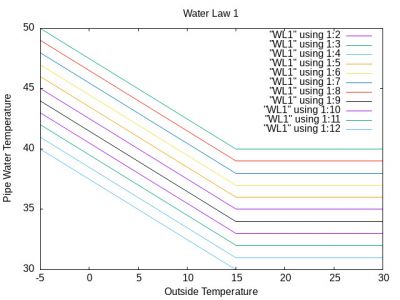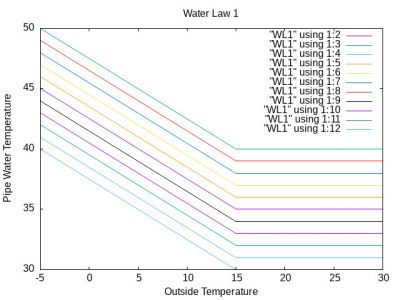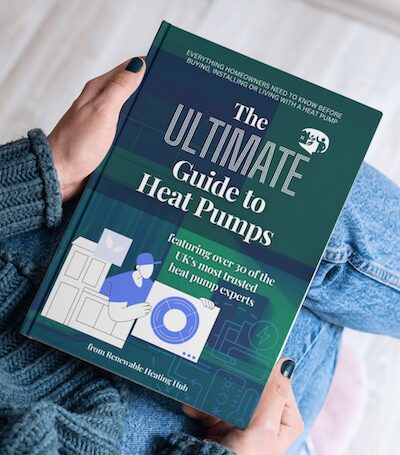Sorry @jamespa but the Water Law Thermostat controls the offset into the Water Law curves themselves.
I , and many others use this to limit energy consumption.
Note the different colours here represent 1 C temperature increments, with the LED panel Offset control displayed and controlled in 0.1 C increments.
Reducing the offset reduces the pipe water Temperature, energy and bills when the excessive Consumption 80%,90% and 100% warnings appear.
I still have Weather compensation , but at a lower Consumption , Temperature and cost!
When very cold I sometimes increase the Water Law Thermostat offset.
During winter, I , and many others , rely on cheaper back up heating when the Temperature falls below +3 C.
Please don't be offended, I do appreciate your advice!
Posted by: @iantelescopeDuring winter, I , and many others , rely on cheaper back up heating when the Temperature falls below +3 C.
What is the backup heating powered by and where is the diagram from. I do understand that you can offset the water law of course. I wouldn't call this a thermostat though, it's an offset control.
The basic idea of WC is to set it up so that the pump always runs at the lowest possible ft consistent with delivering sufficient energy to the house. So if the WC is correctly set up it shouldn't need adjusting unless you want to use backup heating from another source or are prepared to accept a lower room temperature. Am I to understand you do both of these? What is the backup heating powered by and where is the diagram from.
4kW peak of solar PV since 2011; EV and a 1930s house which has been partially renovated to improve its efficiency. 7kW Vaillant heat pump.
My Diagram , I use to it check that the Weather Compensation is working.
To save on Electricity during winter I use an oil filled 600 W room heater and rely on two Electric kettles for Hot water.
I have seen the electric , inline , backup heaters ,on this , and other sites.
I considered putting a Immerser bar into my Buffer tank , as recommended by Kensa and others.
Sorry, this is reality .
I must go now, your previous message has now arrived.................the PC Gremlim continues to pester !
Posted by: @iantelescopeTo save on Electricity during winter I use an oil filled 600 W room heater and rely on two Electric kettles for Hot water.
Sorry but, for any given room temperature, the oil filled radiator won't save on electricity if your heat pump is working correctly. Your heat pump should have a cop of more than 2 even at very low oat. Your oil filled room heater has a cop of exactly 1.
The only way this saves electricity is by reducing the room temperature or if your heat pump isn't working correctly.
Electric inline backup heaters are to supplement an under-specified heat pump, not to save money.
Posted by: @iantelescopeI considered putting a Immerser bar into my Buffer tank , as recommended by Kensa and others.
Again this supplements an under specified heat pump but doesn't save money. It also provides limp home heating if the heat pump fails.
4kW peak of solar PV since 2011; EV and a 1930s house which has been partially renovated to improve its efficiency. 7kW Vaillant heat pump.
Posted by: @jamespaAll noted. Can you post the version of the controller manual you have please so when I look at fsvs there is less scope for confusion
The heat for deicing comes from the system whether it is the house, buffer tank or pipework. It has to be replaced when the heat pump starts working again, so its not free (nothing is free In thermodynamics). In your case, unless the radiator motor is forced on during deicing (by what?) then, unless there is also a call for heat from your thermostat, the radiator motor will be off and, as @ derek-m says, only the primary circuit will contribute heat. Anyway that is now in the past.
It seems to me there is a case for an arrangement of valves so that a buffer tank supplies the deicing heat, not the house, which is recharged when the pump is back in heating mode. I've not seen this in a diagram though, perhaps someone else has.
Can you post the version of the controller manual you have please so when I look at fsvs there is less scope for confusion.
I suspect that you do not require a valve arrangement as you suggest. Once the modifications have been completed, with the buffer tank now acting as a volumiser in the heat pump return pipework, the initial thermal energy required to perform the defrost will be from the water in the volumiser, with any additional energy that may be required coming from the heat emitters. Once the heat pump restarts in heating mode, the heat emitters will be heated first with the return water warming the volumiser.
Ok. From various pieces of evidence it is more or less certain that the system as it will be after your replumbing can operate in WC mode without an external thermostat. FSV2091 and 2092 can be set to 0 and the unit will then ignore any external thermostat. This being the case it's clearly not essential to have one for the unit to operate.
From other various evidence it seems likely, but not yet absolutely certain, that the internal sensor can be used in a similar way to an external thermostat, but if course unlike an external thermostat it is properly matched to the unit.
What is not quite clear is exactly how it interacts with the WC curve. The most probable way is that it acts as a limit. Thus it gets WC curve controls the leaving water temperature and the internal sensor switches the compressor off if the room temperature exceeds the set room temperature.
Given this my recommendation is that you
retain the existing thermostat but disable it by setting fsv2091 and2092 to 0
Ensure you that the internal sensor is enabled (installation/service mode main menu 1, sub menu 1, seg 2 set to 0
Then check what effect changing the room temperature setting actually has, to establish how the internal sensor affects the operation.
If it does act as a limit stat then retain it and discard or sell your Honeywell. If it doesn't then nothing has been lost or spent unnecessarily.
If this interpretation of it's function is correct, then the best way to find the right settings for the water law curve will be, for each set point, to turn down the ft until the house fails to heat to the correct temperature, then then it up by a degree. At this point the internal sensor will kick in and very occasionally may turn the unit off if the house gets too warm, but basically will leave it to run according to the water law curve.
I hope that's clear, but if it isn't please ask, this is a bit difficult to explain and there remains some uncertainty about the exact algorithm applied.
I will look through your fav values in the next day or two, but hopefully the above moves the discussion forward re water law curve and room temperature sensors.
4kW peak of solar PV since 2011; EV and a 1930s house which has been partially renovated to improve its efficiency. 7kW Vaillant heat pump.
Many thanks james.
Over the last two years I have made several attempts at experimentally and sequentially changing the 2091 Parameters .
The results of these experiments was that :
1) Using Field bit 2091 opt 0 , and the Water Temperature thermistor as the controlling sensor , resulted in the Standard display of Water and room Temperature :
I recorded the Water Temperature over several 8 minute cycles.
With the Water Temperature set to 32 C the Temperature climbed to ~38 C and then began falling back to 32 C.
On reaching 32 C the Compressor was called triggering another cycle.
The Heat pump was configured to use the Water Temperature Thermostat as the controlling Temperature sensor.
Without a display , I had no indication of the status of Weather compensation. Was Weather compensation working or NOT?
Others, on this site, angrily defended Samsung , saying that my Weather Compensation was indeed working , it was just that I had no way of either controlling or observing its operation.!
I was, and am , Not impressed.
I, personally, made hundreds of observations without any indication that Weather compensation was working on my Heat Pump.
Others would beg to differ!
I had no control over room Temperatures being without a Thermostat.
2) Using Field bit 2091 options 2,3 or 4, and the Water Temperature thermistor as the controlling sensor , resulted in the Weather compensation , Thermostat display: :
Weather compensation was working and displaying its status:
With the Water Temperature Offset set to 0 C , and an outside Temperature of ~18 C the Water Temperature climbed to ~40 C and then began falling back to 35 C.
With the Water Temperature Offset set to +3 C , and an outside Temperature of ~18 C the Water Temperature climbed to ~41 C and then began falling back to 38 C.
Water compensation was working, and displayed correctly.
Room Temperatures were controlled by the Thermostat.
3)
Using Field bit 2091 options 2,3 or 4, and the Air Temperature thermistor behind the LED control screen used as the controlling sensor , resulted in the Weather compensation , Thermostat display: :
The Heat pump initially produced E121 errors followed by a period of correct operation of Weather compensation.
Weather compensation was working and displaying its status:
With the Water Temperature Offset set to 0 C , and an outside Temperature of ~18 C the Water Temperature climbed to ~40 C and then began falling back to 35 C.
With the Water Temperature Offset set to +3 C , and an outside Temperature of ~18 C the Water Temperature climbed to ~41 C and then began falling back to 38 C.
Water compensation was working, and displaying correctly.
The Room Thermostat worked perfectly .
The Kitchen Temperature Indoor display Temperature also increased or decreased without control.
As a result of these experiments, I have , for most of last two years ,used the 2091 options 3 or 4 being controlled by the Water Temperature Sensor , resulting in a working and displaying Weather Compensation system.
The Room Thermostat continues to work, albeit suffering from horrific "Short Cycling" , being programed to use Octopus "Cosy" , starting between 0400 to 0700 , and 14.00 to 16.00 and again 19.00 to 21.00.
I will , from experience, tread carefully.....allowing for a return to the last working and stable setting.
p.s. The Water Temperature sensor is believed to be located at the Water outlet from the Heat Pump itself.
So far as I can see from the pictures the mode in all of these is set to heat not auto.
My understanding from manual is that WC operates only when the mode is set to auto but this may be wrong.
Also I note that the first says 'water outlet' whereas the others say 'water law'. I thus doubt weather comp was working in the first case, but can't explain why other than that mode is set to heat whereas the manual seems to say it must be set to auto.
You have posted other screenshots where the mode clearly is set to auto.
Are you changing the mode?
TBH I doubt I have the time to review and try to explain all your admirably extensive previous observations.
What I got intend to do when I get time in the next couple of days to propose a set of fsvs ,(largely the ones you already have) and a revised method for tuning weather compensation, using the in-built temperature sensor. This should work so far as I have understood it from the manual, a bit of logic, and what I have seen on several posts and confirmed by a Samsung engineer.
I suggest you set it up this way and see what happens, or ignore my suggestion and do what you think is the right thing to do. If you do the latter I won't be offended, but unless we start from somewhere that seems likely to work, I'm not going to intervene further.
That's all I can really offer. I will post again in the next day or so.
4kW peak of solar PV since 2011; EV and a 1930s house which has been partially renovated to improve its efficiency. 7kW Vaillant heat pump.
Heat Pump philosophy.
Please do not be offended by my ignorance when I pose my basic uncertainty about my understanding of Weather compensation.
Room Temperature or Water Temperature ?
My Heat Pump appears to be controlled , and controlling the pipe Water Temperature , with room temperatures being somewhat of an afterthought.
I have, probably mistakenly, understood the operation of my Heat Pump as two Algorithms,
1) Outside Temperature controlling pipe water Temperature, aka Weather Compensation.
AND - OR
2) Indoor Temperature controlled by a Thermostat or Thermistor.
Outside Temperature controlling pipe water Temperature, aka Weather Compensation.
Weather compensation controls the Water pipe Temperature as a function of Outside Temperature.
The Relationship between Pipe Water Temperature and Outside Temperature is given by the Water Law curves:
With decreasing outside Temperatures the pipe Water Temperature increases.
The amount of thermal energy stored within the Primary Pipes and Buffer tank is proportional to the Water Temperature and Water Volume, pipes plus buffer tank.
Indoor Temperature controlled by a Thermostat or Thermistor.
Controlled by a Physical room Thermostat or a Thermistor located behind my Control panel falling room Temperatures withdraw Heat Energy from that stored within the Pipe Water .
The Pipe and Buffer tank thermal energy stored during the Weather compensation is reduced by the Room Heating demand.
The room Thermostat, or internal Thermistor reducing the Water Temperature until the Weather Compensation Thermostat triggers , demanding a compressor Run cycle .
With the Cycling time here set, unfortunately, by the interfering Thermostat Cycle control time of 10 minutes.
Is my understanding correct ?
Do I have two virtually independent water control systems linked by the storage of heat energy within the pipe water ( and buffer tank)?
The internal Thermistor , without a timer, probably without offset , compensation or Hysteresis settings is surely the poorer option?
Would the removal of the Weather compensation Control and Display ,help or hinder?
Posted by: @iantelescopeWould the removal of the Weather compensation Control and Display ,help or hinder?
Doing this will increase your electricity consumption by 15%. This is a direct result of thermodynamics not engineering and you will not circumvent it. The objective of WC is to set the flow temperature as low as possible consistent with the emitters delivering just enough heat to balance the house loss. This leads to greatest efficiency.
The fundamental here is that lowest flow temperature=highest efficiency. A 1C increase in flow temperature gives a 2-3% decrease in efficiency.
Unfortunately the Samsung WC system is linked only to outside temperature unlike some more sophisticated systems (or Samsung plus homely,) which link to outside temperature but over time auto adapt based on learning the house response. This makes it a bitore tricky to set up but as previously mentioned I will suggest an improved algorithm later.
Posted by: @iantelescopeDo I have two virtually independent water control systems linked by the storage of heat energy within the pipe water ( and buffer tank)?
Currently yes, which is pretty much madness. Worse still the linkage involves the heat exchanger which is an unknown quantity. Finally, and yet even worse, the linkage is suspended when the thermostat stops demanding heat because it switches off the radiator pump. It's a buggers muddle of a control system to say the least.
Please read my previous post on the theory of water law/weather compensation.
If you wish to proceed without WC then please note the inevitable increase in cost.
Please let me know asap if you wish to do this so I can stop wasting my time.
For the avoidance of doubt I'm not offended, but weather compensation, which is fundamental to the efficient operation of heat pumps due to their thermodynamics, has been extensively discussed on this forum and I really don't have the time or inclination to keep reading long posts or to debate whether it should be used in a circumstance where cost is apparently critical.
4kW peak of solar PV since 2011; EV and a 1930s house which has been partially renovated to improve its efficiency. 7kW Vaillant heat pump.
@jamespa I can’t help wondering why WC / WL has an option to switch it off really. Are there situations where the use of such intelligent control would fail to be more efficient?! Regards, Toodles.
Toodles, heats his home with cold draughts and cooks food with magnets.
Posted by: @iantelescopeThe internal Thermistor , without a timer, probably without offset , compensation or Hysteresis settings is surely the poorer option?
Would the removal of the Weather compensation Control and Display ,help or hinder?
There has sometimes been some confusion over what is controlling the Samsung heat pump behind the different displays on the wired remote controller. The attached pdf may help to clarify some of this. If the internal thermistor is used, then weather compensation will be active and controlling the heat pump whenever the thermostat calls for heat. There are extensive timings available within the controller should the user wish to switch the heat pump off at a lower indoor temperature at night for example. The hysteresis is roughly 1degC which may not suit all users, but I have found it comfortable and useful. I need to do further testing, but my feeling is that short cycling when it is milder is less of a problem when using the Samsung thermostat compared with the use of an external thermostat.
The main disadvantage for Ian is that he likes being able to use the Offset control and that option isn't available when using the 'Set Indoor Temperature Display Option' (see attached). But I must stress that weather compensation is active whichever of these two options is selected.
- 26 Forums
- 2,342 Topics
- 53 K Posts
- 660 Online
- 6,000 Members
Join Us!
Worth Watching
Latest Posts
-
RE: Configuring third party dongle for Ecodan local control
@majordennisbloodnok I think the HPDHD diagnosis may be...
By Sheriff Fatman , 10 minutes ago
-
RE: Are We Sleepwalking Into Another Race to the Bottom?
@editor how about a video "ChatGPT vs average heating e...
By ksim , 18 minutes ago
-

RE: External pipework insulation
I don't think we can tell from a photo whether your exi...
By Transparent , 33 minutes ago
-
-
RE: Controlling Daikin Altherma via P1P2 and Home Assistant
@majordennisbloodnok That’s correct. I can’t find anywh...
By weoleyric , 7 hours ago
-
RE: Octopus Cosy Heat Pump Owners & Discussion Thread
@andrewj yeah we recreated it. Engineer seemed to think...
By swwils , 8 hours ago
-

RE: Setback savings - fact or fiction?
@robs — thanks again for your detailed comments. Some r...
By cathodeRay , 1 day ago
-

RE: A Smarter Smart Controller from Homely?
@papahuhu I hope you get a swift resolution. Regards, T...
By Toodles , 1 day ago
-

RE: Poll for Time of Use, tariffs, technology
That’s fine by me too Major, I feel it is a sad reflect...
By Toodles , 1 day ago
-

Bingo. Sometimes a judiciously placed size 10 bovver bo...
By Majordennisbloodnok , 1 day ago
-
RE: Mitsubishi Ecodan 11.2kW heat pump with low COP
@ciocoiu-alexandru I can't provide the same level of di...
By Sheriff Fatman , 1 day ago
-

The three technical issues I'm considering are: BMS...
By Transparent , 1 day ago
-
RE: LiFePO4 lithium battery fires and explosions
@transparent Your post may fit better in th...
By Batpred , 1 day ago
-

RE: British Gas vs Octopus Energy vs Heat Geek vs EDF vs Aira vs OVO vs EON.Next vs Boxt
@jamespawhite, if you could be bothered, you could also...
By Mars , 1 day ago
-
RE: Commencing on an ASHP Installation Process
I've got a bit of time to draft something today, so the...
By Sheriff Fatman , 2 days ago
-
RE: Help with heat pump sizing
@amin I dont think materially relative to t...
By JamesPa , 2 days ago
-

@majordennisbloodnok I have decided to take the plunge....
By TechnoGeek , 2 days ago
-
RE: Different dT on each radiator?
I cant sorry. Its based on some calculations I did fro...
By JamesPa , 3 days ago






